Return to Athletic Activity of a Shetland Pony Mare with Coxofemoral Luxation Treated by Femoral Head Ostectomy
Simple Summary
Abstract
1. Introduction
2. Materials and Methods
2.1. Case History
2.2. Diagnostic Imaging
2.3. Surgery
2.4. Post-Operative Treatment
2.5. Follow-Up
3. Results
4. Discussion
5. Conclusions
Supplementary Materials
Author Contributions
Funding
Institutional Review Board Statement
Informed Consent Statement
Data Availability Statement
Acknowledgments
Conflicts of Interest
References
- Platt, D.; Wright, I.M.; Houlton, J.E.F. Treatment of chronic coxofemoral luxation in a Shetland pony by excision arthroplasty of the femoral head: A case report. Br. Vet. J. 1990, 146, 374–379. [Google Scholar] [CrossRef] [PubMed]
- Malark, J.A.; Nixon, A.J.; Haugland, M.A.; Brown, M.P. Equine coxofemoral luxations: 17 cases (1975–1990). Cornell Vet. 1992, 82, 79–90. [Google Scholar]
- Toth, F.; Adair, H.S.; Holder, T.E.C. Femoral head ostectomy to treat a donkey for coxofemoral luxation. Equine Vet. Educ. 2007, 19, 478–481. [Google Scholar] [CrossRef]
- Field, J.R.; McLaughlin, R.; Davies, M. Surgical repair of coxofemoral luxation in a miniature horse. Can. Vet. J. 1992, 33, 404–405. [Google Scholar] [PubMed]
- Sprick, M.; Koch, C. Successful treatment of a coxofemoral luxation in a Shetland pony by closed reduction and prolonged immobilization using a full-body animal rescue sling. Case Rep. Vet. Med. 2020, 2020, 2424653. [Google Scholar] [CrossRef] [PubMed]
- Garcia-Lopez, J.M.; Boudrieau, R.J.; Provost, P.J. Surgical repair of coxofemoral luxation in a horse. J. Am. Vet. Med. Assoc. 2001, 219, 1254–1258. [Google Scholar] [CrossRef] [PubMed]
- Starke, A.; Herzog, K.; Short, J.; Haist, V.; Hohling, A.; Baumgartner, W.; Reage, J. Diagnostic procedure and surgical treatment of craniodorsal coxofemoral luxation in calves. Vet. Surg. 2007, 36, 99–106. [Google Scholar] [CrossRef]
- Rothenbacher, H.; Hokasen, J.F. Coxofemoral joint luxation in a quarter horse. J. Am. Vet. Med. Ass. 1965, 147, 148–150. [Google Scholar]
- Gracia Calvo, L.A.; Martin-Cuervo, M.; Pena, E.; Fruto, J.; Jemenez, J.; Ezquerra, I.J. Femoral head excision after coxofemoral luxation in an Arab filly: Four years follow up. Equine Vet. Educ. 2011, 23, 346–352. [Google Scholar] [CrossRef]
- Bennett, D.; Campbell, J.R.; Rawlinson, J.R. Coxofemoral luxation complicated by upward fixation of the patella in the pony. Equine Vet. J. 1977, 9, 192–194. [Google Scholar] [CrossRef]
- Amitrano, F.N.; Gutierrez-Nibeyro, S.D.; Joslyn, S.K. Radiographic diagnosis of craniodorsal coxofemoral luxation in standing equids. Equine Vet. Educ. 2014, 26, 255–258. [Google Scholar] [CrossRef]
- Trotter, G.W.; Auer, J.A.; Arden, W.; Parks, A. Coxofemoral luxation in two foals wearing hindlimb cast. J. Am. Vet. Med. Assoc. 1986, 189, 560–561. [Google Scholar] [CrossRef]
- Portier, K.; Walsh, C.M. Coxofemoral luxation in a horse during recovery from general anesthesia. Vet. Rec. 2006, 159, 84–85. [Google Scholar] [CrossRef] [PubMed]
- Mackay-Smith, M.P. Management of fracture and luxation of the femoral head in two ponies. J. Am. Vet. Med. Assoc. 1964, 145, 248–251. [Google Scholar]
- Clegg, P.D.; Butson, R.J. Treatment of a coxofemoral luxation secondary to upward fixation of the patella in a Shetland pony. Vet. Rec. 1996, 138, 134–137. [Google Scholar] [CrossRef]
- Clegg, P.D.; Comerford, E.J. Coxofemoral luxation-how does our knowledge of treatment in other species help us in the horse? Equine Vet. Educ. 2007, 19, 482–483. [Google Scholar] [CrossRef]
- Squire, R.E.; Fessler, J.F.; Toombs, J.P.; Van Sickle, D.C.; Blevins, W.E. Femoral head ostectomy in horses and cattle. Vet. Surg. 1991, 20, 453–458. [Google Scholar] [CrossRef] [PubMed]
- François, B.; Thomas, A.L.; Lepage, O.M. Treatment of coxofemoral luxation in a mature Welsh pony by femoral head ostectomy: Long-term outcome. Equine Vet. Educ. 2017, 29, 528–533. [Google Scholar] [CrossRef]
- Richardson, D.W.; Ortved, K.F. Femur and pelvis. In Equine Surgery, 5th ed.; Auer, J., Stick, J., Kuemmerle, J., Prange, T., Eds.; Elsevier: St. Louis, MO, USA, 2019; pp. 1777–1789. [Google Scholar]
- Nixon, A.J.; Ducharme, N.G. Luxation and subluxation of the coxofemoral joint. In Equine Fracture Repair, 2nd ed.; Nixon, A.J., Ed.; Jhon Wiley & Sons Inc.: Hoboken, NJ, USA, 2020; pp. 706–721. [Google Scholar]
- Muller, E.M.T.; Ehrle, A.; Pozzi, A.; Lasarzik de Ascurra, J.; Lischer, C.J.; Kummerle, J.M. Modified toggle pin technique combined with prosthetic capsular reconstruction for surgical stabilisation of coxofemoral luxation in a Shetland pony. Vet. Surg. 2023, 52, 221–228. [Google Scholar] [CrossRef]
- Garcia-Lopez, J.M. Coxofemoral luxations in the horse: Surgical options and challenges. Equine Vet. Ed. 2010, 22, 554–556. [Google Scholar] [CrossRef]
- Ducharme, N.G.; Trostle, S.S. Coxofemoral luxation/subluxation. In Farm Animal Surgery, 1st ed.; Fubini, S.L., Ducharme, N.G., Eds.; Saunders: St. Louis, MO, USA, 2004; pp. 346–347. [Google Scholar]
- Van den Boom, R.; Rijkenhuizen, A.B.M.; Mej, B.P. Femoral head ostectomy following osteotomy of the greater trochanter in a pony with chronic coxofemoral luxation. Pferdeheilkunde 2003, 19, 246–252. [Google Scholar] [CrossRef]
- Plante, J.; Dupuis, J.; Beauregatd, J.; Bonneau, N.H.; Breton, L. Long term results of conservative treatment, excision arthroplasty and triple pelvic osteotomy for the treatment of hip dysplasia in the immature dog. Part 1 Radiographic and physical results. Vet. Comp. Orthop. Traumatol. 1997, 10, 101–110. [Google Scholar]
- Duff, R.; Campbell, J.R. Effects of experimental excision arthroplasty of the hip joint. Res. Vet. Sci. 1978, 24, 174–181. [Google Scholar] [CrossRef] [PubMed]
- Duff, R.; Campbell, J.R. Radiographic appearance and clinical progress after excision arthroplasty of the canine hip. J. Small Anim. Pract. 1978, 19, 439–449. [Google Scholar] [CrossRef] [PubMed]
- Ludwig, E.K.; Byron, C.R. Femoral head ostectomy and medial patellar ligament desmotomy to treat a pregnant miniature horse with coxofemoral joint luxation and upward fixation of the patella. Can. Vet. J. 2017, 58, 498–502. [Google Scholar]
- Kuemmerle, J.M.; Fürst, A.E. Treatment of a coxofemoral luxation in a pony using a prosthetic capsule technique. Vet. Surg. 2011, 40, 631–635. [Google Scholar] [CrossRef] [PubMed]
- Huggons, N.; Andrea, R.; Grant, B.; Duncan, C. Total hip arthroplasty in the horse: Overview, technical considerations and case report. Equine Vet. Educ. 2010, 22, 547–553. [Google Scholar] [CrossRef]
- Cullen, M.D.; Pettitt, R.A.; Tomlinson, A.W.; Louro, L.F.; Bennell, A.J.; Michael, R.; Stack, J.D. Successful total hip arthroplasty in a miniature horse. Vet. Surg. 2023, 52, 1209–1218. [Google Scholar] [CrossRef] [PubMed]
- Sullins, K.E.; Baxter, G.M. The femur and coxofemoral joint. In Adams and Stashak’s Lameness in Horses, 6th ed.; Baxter, G.M., Ed.; Wiley-Blackwell: Oxford, UK, 2011; pp. 814–832. [Google Scholar]
- Little, C.; Hilbert, B. Pelvic fractures in horses: 19 cases (1974–1984). J. Am. Vet. Med. Assoc. 1987, 190, 1203–1205. [Google Scholar] [CrossRef] [PubMed]
- Rutkowski, J.A.; Richardson, D.W. A retrospective study of 100 pelvic fractures in horses. Equine Vet. J. 1989, 21, 256–259. [Google Scholar] [CrossRef]
- Almanza, A.; Whitcomb, M.B. Ultrasonographic diagnosis of pelvic fractures in 28 horses. Proc. Am. Assoc. Equine Pract. 2003, 49, 50–54. [Google Scholar]
- Brenner, S.; Whitcomb, M.B. Ultrasonographic diagnosis of coxofemoral subluxation in horses. Vet. Radiol. Ultrasound 2009, 50, 423–428. [Google Scholar] [CrossRef] [PubMed]
- DeCamp, C.E.; Johnston, S.A.; Dejardin, L.M.; Schaefer, S.L. Hip joint. In Brinker, Piermattei, and Flo’s Handbook of Small Animal Orthopedics and Fracture Repair, 5th ed.; Elsevier: St. Louis, MO, USA, 2016; pp. 508–513. [Google Scholar]
- Tsuka, T.; Okamoto, Y.; Nishiyama, A.; Morita, T. Case report: Imaging of septic arthritis in the hip joint of a calf treated with femoral head ostectomy. Front. Vet. Sci. 2024, 11, 1292924. [Google Scholar] [CrossRef]
- Berzon, J.I.; Howard, P.E.; Covell, S.J.; Trotter, E.J.; Dueland, R. A retrospective study of the efficacy of femoral head and neck excision in 94 dogs and cats. Vet. Surg. 1980, 9, 88–92. [Google Scholar] [CrossRef]
- Atkin, L.; Stephenson, J.; Ousey, K. Feasibility study to evaluate cycloidal vibration therapy for the symptomatic treatment of intermittent claudication. Pilot. Feasibility Stud. 2019, 5, 133. [Google Scholar] [CrossRef] [PubMed]
- Snowden, R.T.; Anderson, D.E.; Ursini, T.; Mulon, P.Y. Femoral head ostectomy as a treatment for craniodorsal coxofemoral luxation in an 18-month-old shorthorn heifer. Vet. Rec. Case Rep. 2019, 7, e000778. [Google Scholar] [CrossRef]
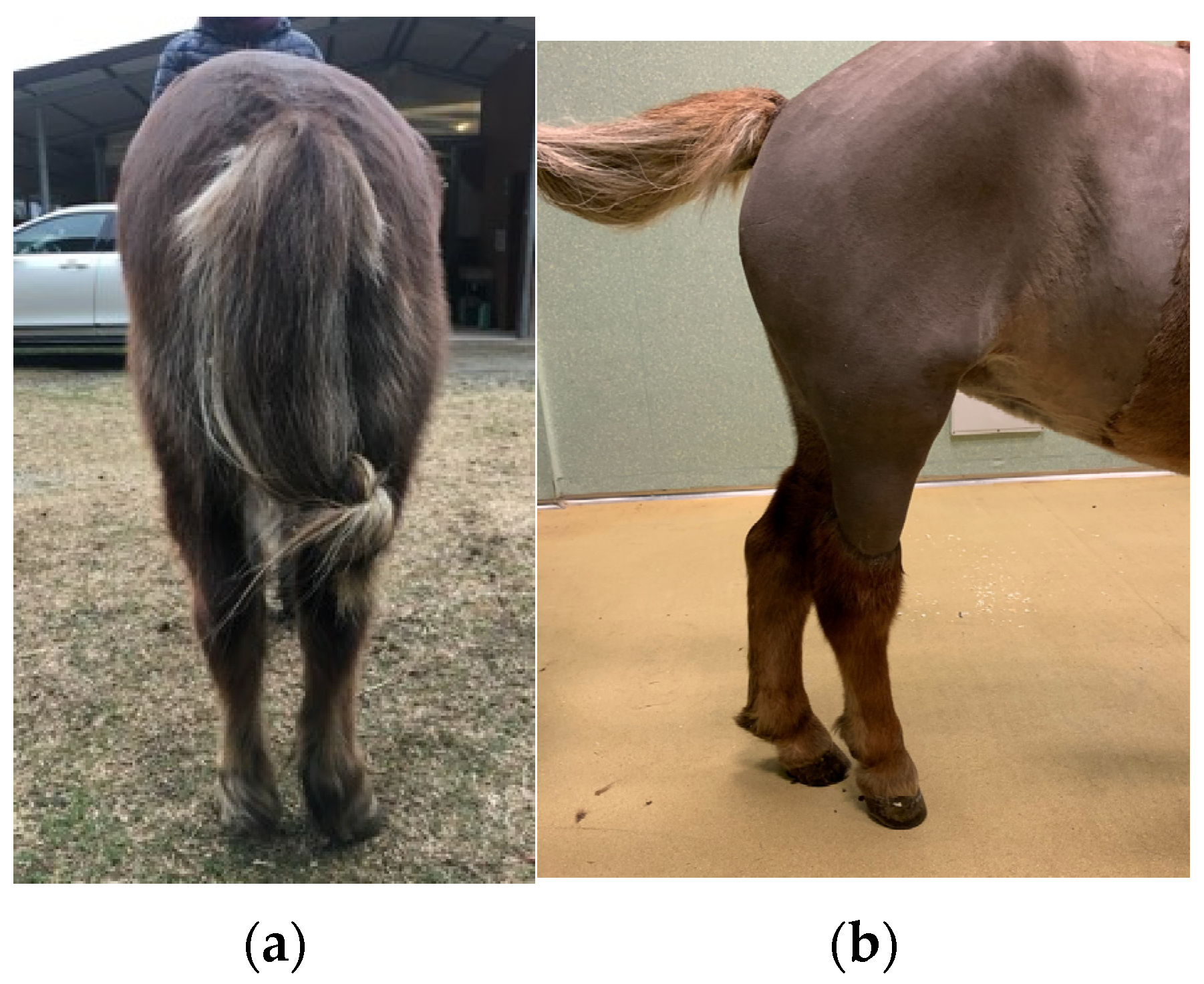
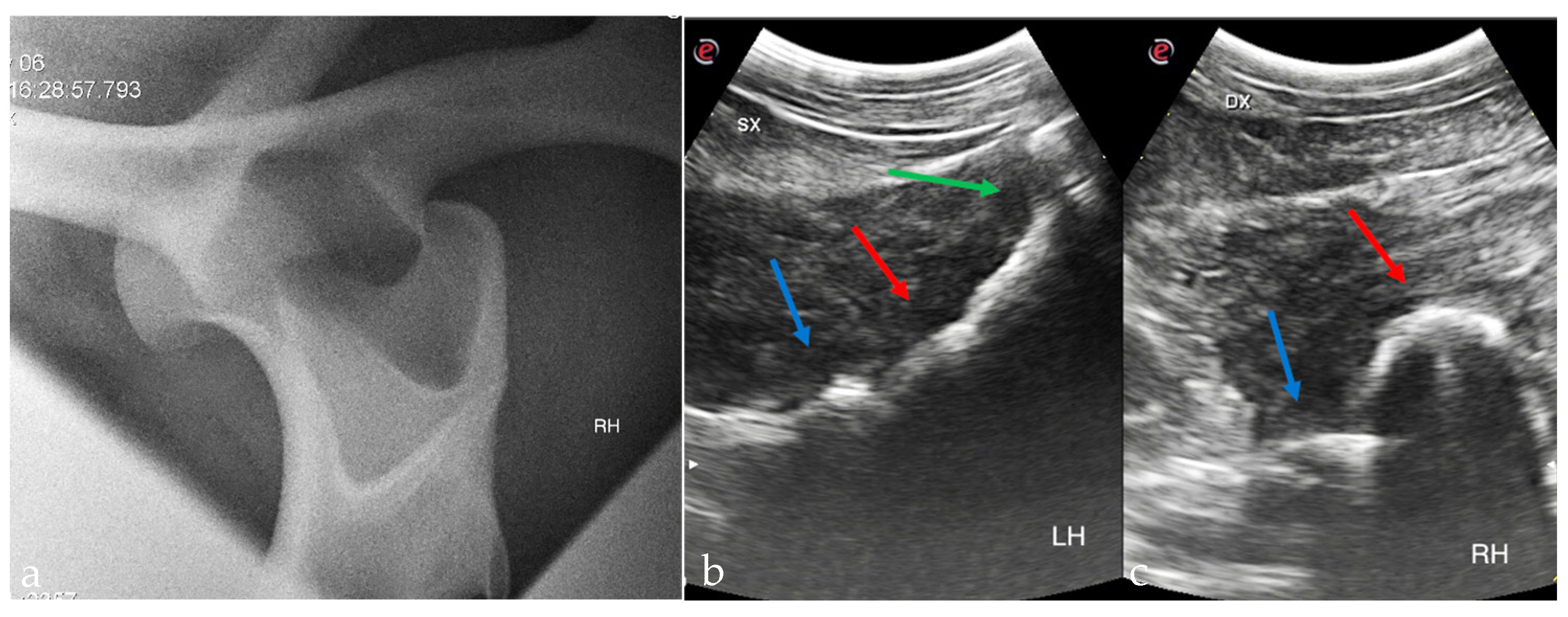
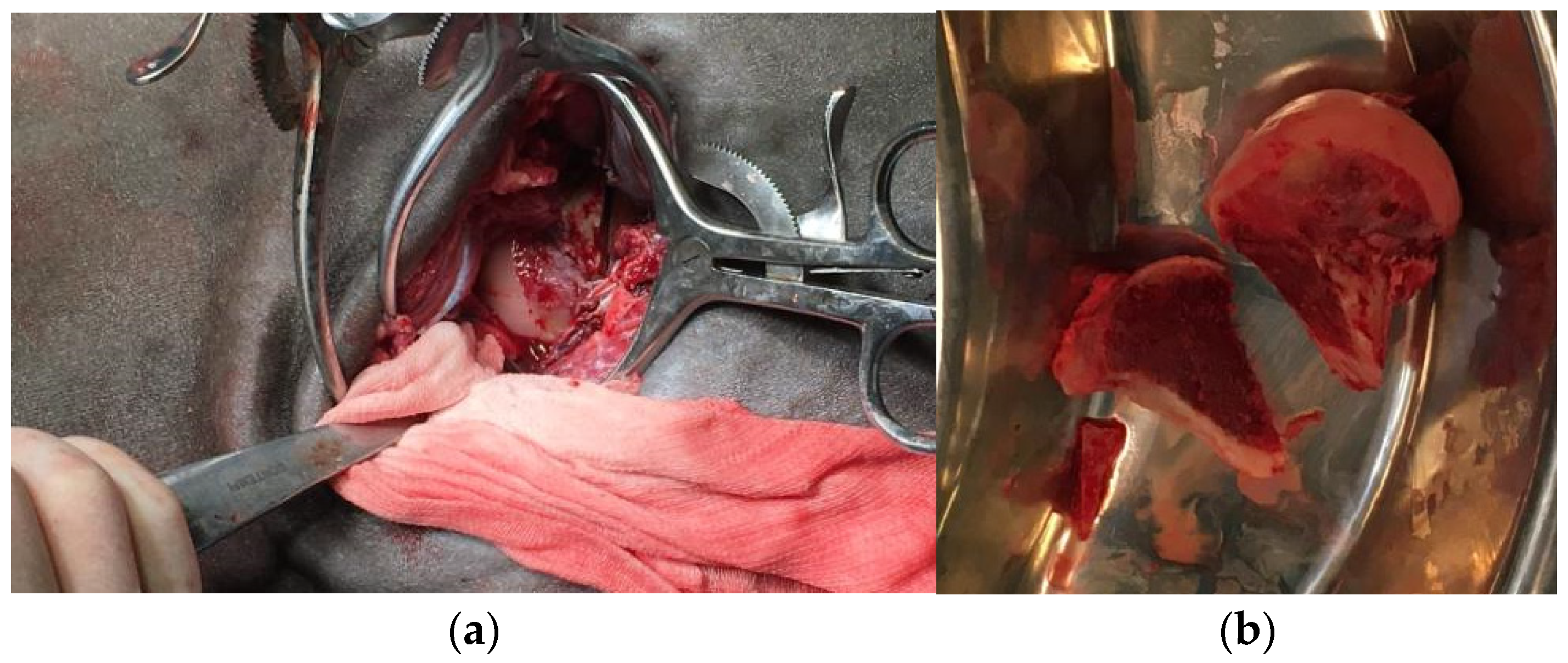
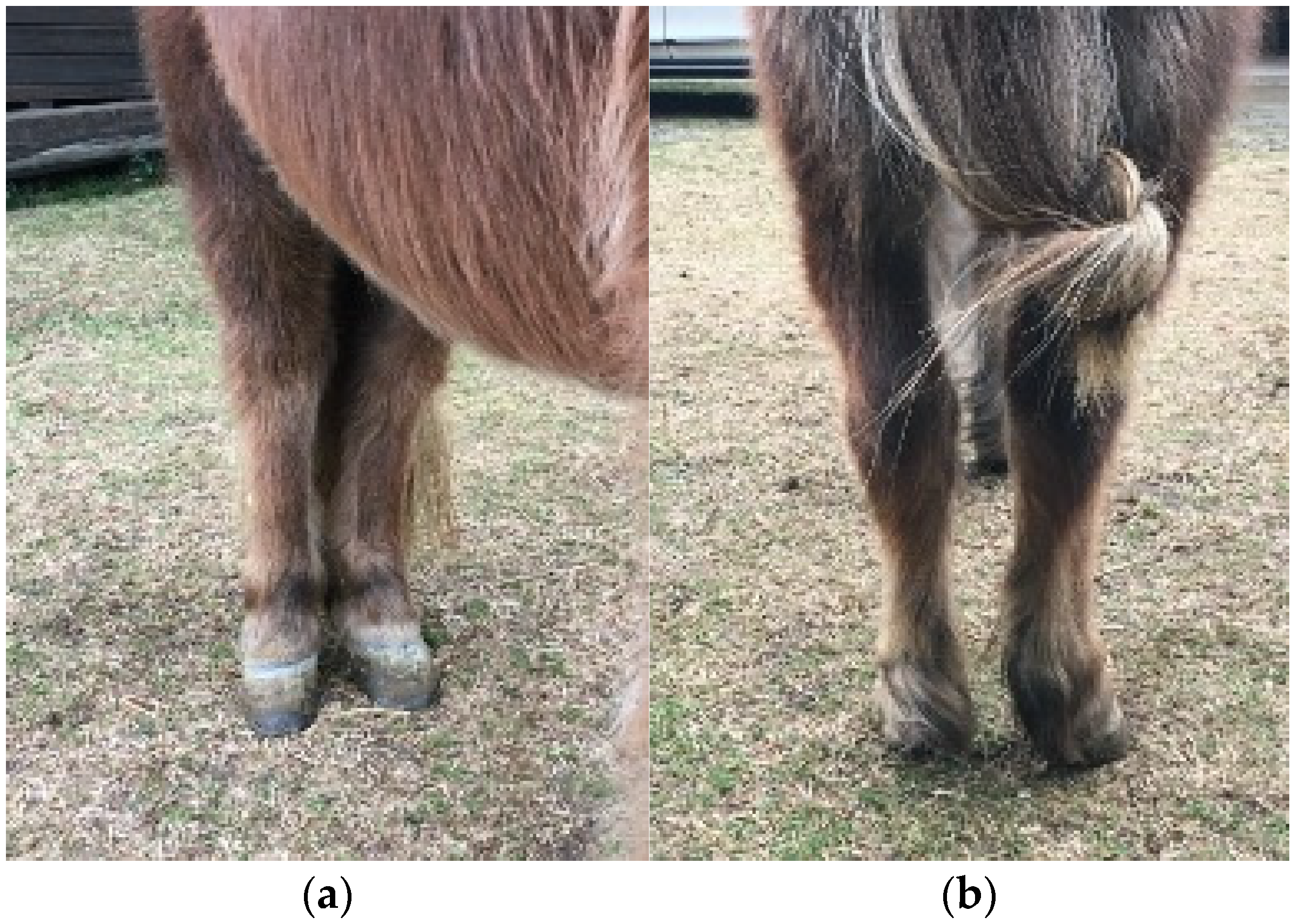
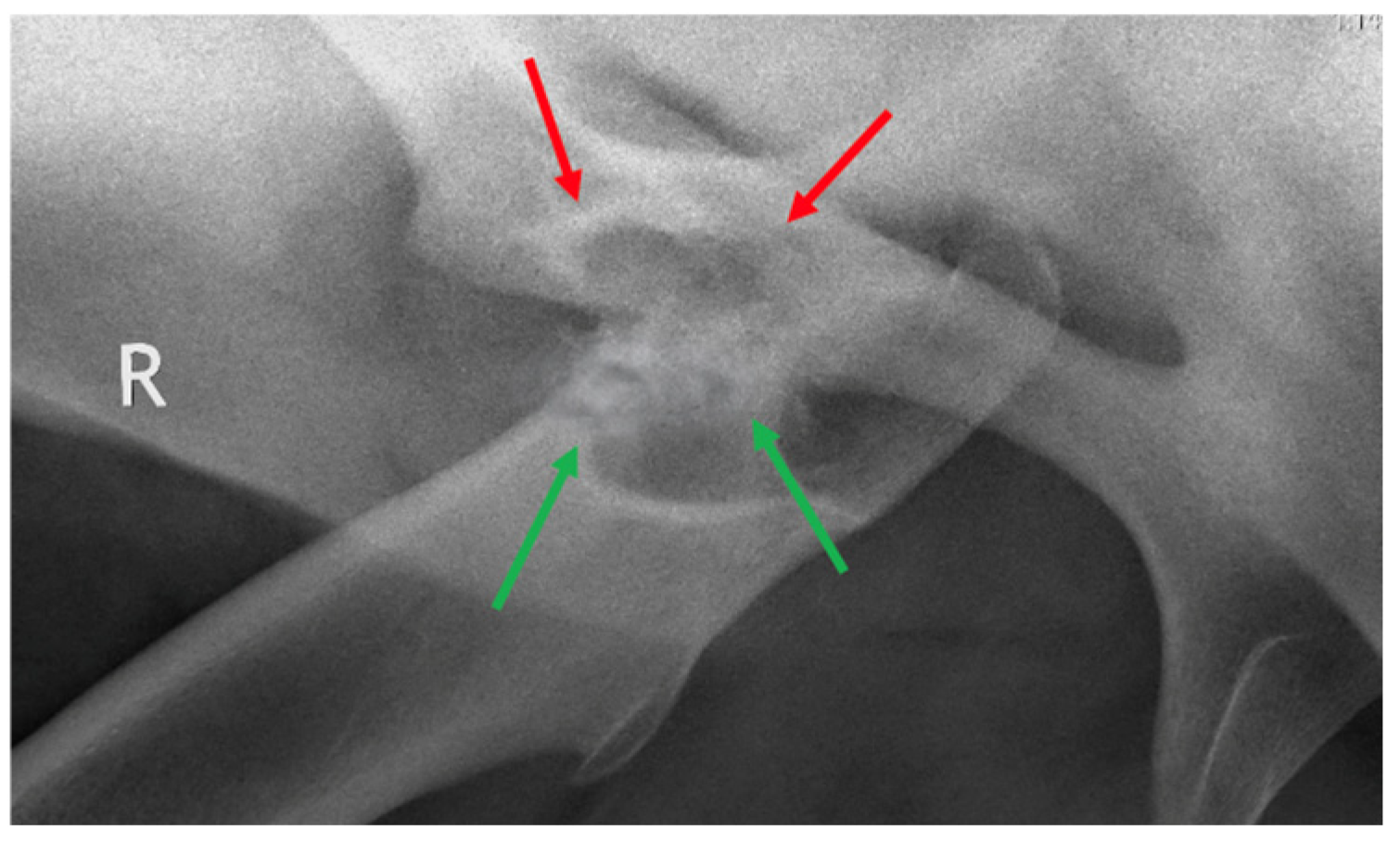
Disclaimer/Publisher’s Note: The statements, opinions and data contained in all publications are solely those of the individual author(s) and contributor(s) and not of MDPI and/or the editor(s). MDPI and/or the editor(s) disclaim responsibility for any injury to people or property resulting from any ideas, methods, instructions or products referred to in the content. |
© 2025 by the authors. Licensee MDPI, Basel, Switzerland. This article is an open access article distributed under the terms and conditions of the Creative Commons Attribution (CC BY) license (https://creativecommons.org/licenses/by/4.0/).
Share and Cite
Carnevale, L.; Tagliabue, T.; Rabbogliatti, V.; Bona, R.; Cavallier, F. Return to Athletic Activity of a Shetland Pony Mare with Coxofemoral Luxation Treated by Femoral Head Ostectomy. Animals 2025, 15, 497. https://doi.org/10.3390/ani15040497
Carnevale L, Tagliabue T, Rabbogliatti V, Bona R, Cavallier F. Return to Athletic Activity of a Shetland Pony Mare with Coxofemoral Luxation Treated by Femoral Head Ostectomy. Animals. 2025; 15(4):497. https://doi.org/10.3390/ani15040497
Chicago/Turabian StyleCarnevale, Liliana, Tania Tagliabue, Vanessa Rabbogliatti, Roberto Bona, and Francesca Cavallier. 2025. "Return to Athletic Activity of a Shetland Pony Mare with Coxofemoral Luxation Treated by Femoral Head Ostectomy" Animals 15, no. 4: 497. https://doi.org/10.3390/ani15040497
APA StyleCarnevale, L., Tagliabue, T., Rabbogliatti, V., Bona, R., & Cavallier, F. (2025). Return to Athletic Activity of a Shetland Pony Mare with Coxofemoral Luxation Treated by Femoral Head Ostectomy. Animals, 15(4), 497. https://doi.org/10.3390/ani15040497





